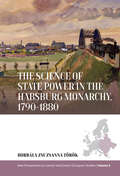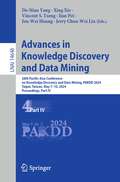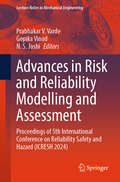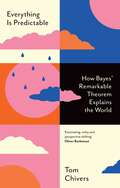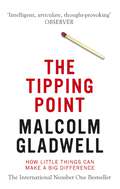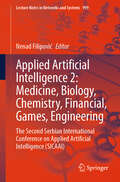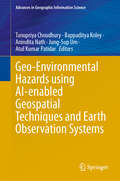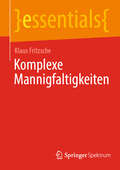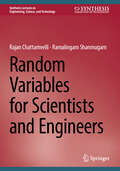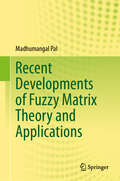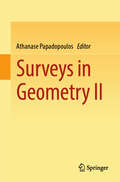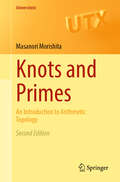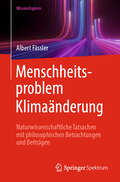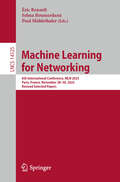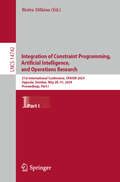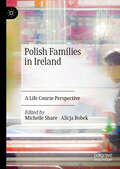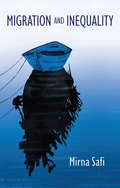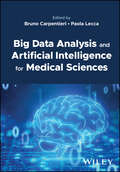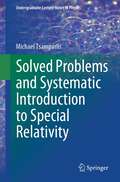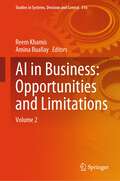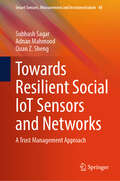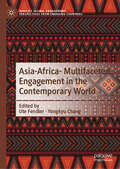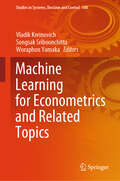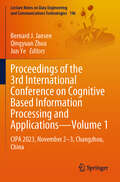- Table View
- List View
The Science of State Power in the Habsburg Monarchy, 1790-1880 (New Perspectives on Central and Eastern European Studies #5)
by Borbala Zsuzsanna TörökThe formation of modern European states during the long 19th century was a complicated process, challenged by the integration of widely different territories and populations. The Science of State Power in the Habsburg Monarchy, 1790-1880 builds on recent research to investigate the history of statistics as an overlooked part of the sciences of the state in Habsburg legal education as well as within the broader public sphere. By exploring the practices and social spaces of statistics, author Borbála Zsuzsanna Török uncovers its central role in imagining the composite Habsburg Monarchy as a modern and unified administrative space.
The Science of State Power in the Habsburg Monarchy, 1790-1880 (New Perspectives on Central and Eastern European Studies #5)
by Borbala Zsuzsanna TörökThe formation of modern European states during the long 19th century was a complicated process, challenged by the integration of widely different territories and populations. The Science of State Power in the Habsburg Monarchy, 1790-1880 builds on recent research to investigate the history of statistics as an overlooked part of the sciences of the state in Habsburg legal education as well as within the broader public sphere. By exploring the practices and social spaces of statistics, author Borbála Zsuzsanna Török uncovers its central role in imagining the composite Habsburg Monarchy as a modern and unified administrative space.
Advances in Knowledge Discovery and Data Mining: 28th Pacific-Asia Conference on Knowledge Discovery and Data Mining, PAKDD 2024, Taipei, Taiwan, May 7–10, 2024, Proceedings, Part IV (Lecture Notes in Computer Science #14648)
by Vincent S. Tseng Jerry Chun-Wei Lin Xing Xie Jian Pei De-Nian Yang Jen-Wei HuangThe 6-volume set LNAI 14645-14650 constitutes the proceedings of the 28th Pacific-Asia Conference on Knowledge Discovery and Data Mining, PAKDD 2024, which took place in Taipei, Taiwan, during May 7–10, 2024. The 177 papers presented in these proceedings were carefully reviewed and selected from 720 submissions. They deal with new ideas, original research results, and practical development experiences from all KDD related areas, including data mining, data warehousing, machine learning, artificial intelligence, databases, statistics, knowledge engineering, big data technologies, and foundations.
Advances in Risk and Reliability Modelling and Assessment: Proceedings of 5th International Conference on Reliability Safety and Hazard (ICRESH 2024) (Lecture Notes in Mechanical Engineering)
by Prabhakar V. Varde Gopika Vinod N. S. JoshiThis book presents the proceedings of the 5th International Conference on Reliability Safety & Hazard-2024, held in Mumbai during February 21–24, 2024. It covers the latest advances in artificial intelligence and machine learning in development of risk-conscious culture. Various topics covered in this volume are reliability prediction, precursor event analysis, fuzzy reliability, structural reliability, passive system reliability, digital system reliability, risk-informed approach to decision making, dynamic PSA, uncertainty and sensitivity modeling, among others. The book is a valuable resource for researchers and professionals working in both academia and industry in the areas of complex systems, safety-critical systems, and risk-based engineering.
Everything Is Predictable: How Bayes' Remarkable Theorem Explains the World
by Tom ChiversThomas Bayes was an eighteenth-century Presbyterian minister and amateur mathematician whose obscure life belied the profound impact of his work. Like most research into probability at the time, his theorem was mainly seen as relevant to games of chance, like dice and cards. But its implications soon became clear. Bayes' theorem helps explain why highly accurate screening tests can lead to false positives, causing unnecessary anxiety for patients. A failure to account for it in court has put innocent people in jail. But its influence goes far beyond practical applications. A cornerstone of rational thought, Bayesian principles are used in modelling and forecasting. 'Superforecasters', a group of expert predictors who outperform CIA analysts, use a Bayesian approach. And many argue that Bayes' theorem is not just a useful tool, but a description of almost everything - that it is the underlying architecture of rationality, and of the human brain. Fusing biography, razor-sharp science communication and intellectual history, Everything Is Predictable is a captivating tour of Bayes' theorem and its impact on modern life. From medical testing to artificial intelligence, Tom Chivers shows how a single compelling idea can have far-reaching consequences.
The Tipping Point: How Little Things Can Make a Big Difference
by Malcolm Gladwell'A wonderful page-turner about a fascinating idea that should affect the way every thinking person thinks about the world around him' Michael LewisIn this brilliant and original book, Malcolm Gladwell explains and analyses the 'tipping point', that magic moment when ideas, trends and social behaviour cross a threshold, tip and spread like wildfire. Taking a look behind the surface of many familiar occurrences in our everyday world, Gladwell explains the fascinating social dynamics that cause rapid change.'Hip and hopeful, THE TIPPING POINT is like the idea it describes: concise, elegant but packed with social power. A book for anyone who cares about how society works and how we can make it better' George Stephanopoulos
Applied Artificial Intelligence 2: The Second Serbian International Conference on Applied Artificial Intelligence (SICAAI) (Lecture Notes in Networks and Systems #999)
by Nenad FilipovićThe book Applied Artificial Intelligence 2: Medicine, Biology, Chemistry, Financial, Games, Engineering is providing exceptional chapters of the state-of-the-art research knowledge and results on the innovative theories, methodology and applications of artificial intelligence and its sub-domain like deep learning, machine learning in different areas such as medicine, economy, education, law, smart city, government, industry etc. Innovative research ideas on how to solve problems using artificial intelligence, both in R&D and real-time applications are presented. Chapters describe the advanced prototypes, systems, methodologies, tools and techniques and general survey papers, which indicate future directions. These Chapters are extended papers from the Second Serbian International Conference on Applied Artificial Intelligence (SICAAI), which was held in Kragujevac, Serbia, on May 19-20, 2023
Geo-Environmental Hazards using AI-enabled Geospatial Techniques and Earth Observation Systems (Advances in Geographic Information Science)
by Jung-Sup Um Tanupriya Choudhury Bappaditya Koley Anindita Nath Atul Kumar PatidarThis edited collection provides a comprehensive exploration of cutting-edge ideas, approaches, simulations, evaluations of risk, and systems that enhance the practicality of current geospatial technologies for reducing hazard risks. The various sections within this book delve into subjects such as the foundational principles of Earth Observation Systems (EOS) and geospatial methodologies. Additionally, the text serves as an advisory resource on the collaborative use of satellite-derived data and artificial intelligence to track and alleviate geo-environmental threats. The volume imparts extensive understanding regarding geo-environmental dangers and their analysis via EOS along with geospatial strategies. It encompasses key hazard-related themes including coastal degradation, predisposition to landslides, mapping vegetation coverages, tropical storm patterns, soil depletion due to erosion processes, vulnerability to rapid or extended flooding events, variations in oceansurface temperatures alongside chlorophyll-a levels; it also addresses assessments related to groundwater reserves and quality measures as well as sustainable management practices for watersheds that support community livelihoods—all through leveraging AI-integrated geospatial tools in conjunction with earth observation technologies. Furthermore, this work engages in discourse about systems designed for mitigating these ecological challenges sustainably. Scholars engaged in research activities; educational professionals; those involved in landscape design; engineers working at ground level; individuals responsible for policy-making—all who are concerned with geo-environmental hazards or associated domains—will find valuable insights within these pages.
Komplexe Mannigfaltigkeiten (essentials)
by Klaus FritzscheNach einer Einführung in die holomorphen Funktionen von mehreren Veränderlichen wird die Welt der komplexen Mannigfaltigkeiten vorgestellt, insbesondere Untermannigfaltigkeiten, analytische Mengen und tangentiale Strukturen. Weitere Themen sind komplexe Vektorbündel, Liegruppen und Quotientenstrukturen. Wichtigste Beispiele sind die Steinschen Mannigfaltigkeiten, sowie die projektiv-algebraischen Mengen mit ihrer Beziehung zur algebraischen Geometrie.
Random Variables for Scientists and Engineers (Synthesis Lectures on Engineering, Science, and Technology)
by Ramalingam Shanmugam Rajan ChattamvelliThis book provides an introductory overview of random variables and their transformations. The authors approach the topic with statistics students in mind, along with researchers in various fields who are interested in data analysis. The book begins with by defining and explaining mathematical expectation. The authors then discuss transformations of random variables, including distribution functions and special functions. The book also covers joint probability distribution and its applications. The authors have updated and expanded upon their writing on these topics, which they originally covered in their previous book, Statistics for Scientists and Engineers.
Recent Developments of Fuzzy Matrix Theory and Applications
by Madhumangal PalThis book provides a comprehensive overview of the development of fuzzy matrix theory from its inception to its current state. It covers various types of fuzzy matrices, such as intuitionistic fuzzy matrices, interval-valued fuzzy matrices, interval-valued intuitionistic fuzzy matrices, bipolar fuzzy matrices, picture fuzzy matrices, neutrosophic fuzzy matrices, m-polar fuzzy matrices and similar one. Drawing primarily from the author's research work and collaborations, the book offers a state-of-the-art discussion of these topics. Theoretical concepts are illustrated with examples for clarity, accompanied by figures depicting fuzzy matrices and their variations. Suitable for both beginners and expert researchers, the book offers a wealth of material and includes numerous open problems at the end of almost all chapters to encourage further exploration and investigation.
Surveys in Geometry II
by Athanase PapadopoulosThe book is the second volume of a collection which consists of surveys that focus on important topics in geometry which are at the heart of current research. The topics in the present volume include the conformal and the metric geometry of surfaces, Teichmüller spaces, immersed surfaces of prescribed extrinsic curvature in 3-dimensional manifolds, symplectic geometry, the metric theory of Grassmann spaces, homogeneous metric spaces, polytopes, the higher-dimensional Gauss–Bonnet formula, isoperimetry in finitely generated groups and Coxeter groups.Each chapter is intended for graduate students and researchers. Several chapters are based on lectures given by their authors to middle-advanced level students and young researchers. The whole book is intended to be an introduction to important topics in geometry.
Knots and Primes: An Introduction to Arithmetic Topology (Universitext)
by Masanori MorishitaThis book provides a foundation for arithmetic topology, a new branch of mathematics that investigates the analogies between the topology of knots, 3-manifolds, and the arithmetic of number fields. Arithmetic topology is now becoming a powerful guiding principle and driving force to obtain parallel results and new insights between 3-dimensional geometry and number theory.After an informative introduction to Gauss' work, in which arithmetic topology originated, the text reviews a background from both topology and number theory. The analogy between knots in 3-manifolds and primes in number rings, the founding principle of the subject, is based on the étale topological interpretation of primes and number rings. On the basis of this principle, the text explores systematically intimate analogies and parallel results of various concepts and theories between 3-dimensional topology and number theory. The presentation of these analogies begins at an elementary level, gradually building to advanced theories in later chapters. Many results presented here are new and original.References are clearly provided if necessary, and many examples and illustrations are included. Some useful problems are also given for future research. All these components make the book useful for graduate students and researchers in number theory, low dimensional topology, and geometry.This second edition is a corrected and enlarged version of the original one. Misprints and mistakes in the first edition are corrected, references are updated, and some expositions are improved. Because of the remarkable developments in arithmetic topology after the publication of the first edition, the present edition includes two new chapters. One is concerned with idelic class field theory for 3-manifolds and number fields. The other deals with topological and arithmetic Dijkgraaf–Witten theory, which supports a new bridge between arithmetic topology and mathematical physics.
Menschheitsproblem Klimaänderung: Naturwissenschaftliche Tatsachen mit philosophischen Betrachtungen und Beiträgen
by Albert FässlerDas vorliegende Buch analysiert den zukünftigen Temperaturverlauf der Erdoberfläche mithilfe eines naturwissenschaftlichen Modells und gibt eine Übersicht über die Ursachen und Auswirkungen des Klimawandels. Der Inhalt umfasst außerdem relevante Daten und Fakten zu den Themen Kohlenstoffbudget, Demographie, Gletscher, Permafrost, Artenvielfalt, Mobilität und Extremwetter. Die rasche globale Reduzierung des CO2-Anstiegs auf Netto-Null ist eine dringende Notwendigkeit, um nachfolgenden Generationen ein menschenwürdiges Leben zu ermöglichen. Die Industriestaaten tragen als Hauptverursacher eine moralische Verantwortung, die erwähnte Reduzierung zügig umzusetzen und die Entwicklungsländer in diesem Prozess zu unterstützen. Das Buch richtet sich auch an Personen mit wenig Bezug zur Mathematik.Die Produktfamilie WissensExpress bietet Ihnen Lehr- und Lernbücher in kompakter Form. Die Bücher liefern schnell und verständlich fundiertes Wissen.
Machine Learning for Networking: 6th International Conference, MLN 2023, Paris, France, November 28–30, 2023, Revised Selected Papers (Lecture Notes in Computer Science #14525)
by Selma Boumerdassi Éric Renault Paul MühlethalerThis book constitutes the refereed proceedings of the 6th International Conference on Machine Learning for Networking, MLN 2023, held in Paris, France, during November 28–30, 2023. The 18 full papers included in this book were carefully reviewed and selected from 34 submissions. The conference aims at providing a top forum for researchers and practitioners to present and discuss new trends in machine learning, deep learning, pattern recognition and optimization for network architectures and services.
Integration of Constraint Programming, Artificial Intelligence, and Operations Research: 21st International Conference, CPAIOR 2024, Uppsala, Sweden, May 28–31, 2024, Proceedings, Part I (Lecture Notes in Computer Science #14742)
by Bistra DilkinaThis book constitutes the proceedings of the 21st International Conference on the Integration of Constraint Programming, Artificial Intelligence, and Operations Research, CPAIOR 2024, held in Uppsala, Sweden, during May 28–31, 2024. The 33 full papers and the 9 short papers presented in the proceedings were carefully reviewed and selected from a total of 104 submissions. The content of the papers focus on new techniques or applications in the area and foster the integration of techniques from different fields dealing with large and complex problems.
Polish Families in Ireland: A Life Course Perspective
by Alicja Bobek Michelle ShareThis volume explores the family formation and life course of Polish people in Ireland, who make up the largest immigrant group in Ireland. Chapters address key dimensions of the life course in three parts focusing on childhood and youth, adulthood and parenting, and mid-life and futures. Contributions investigate the experiences of children and youth attending school and understanding their identities, the changing nature of families and family support, how families might engage with welfare institutions, and more. Through the life course approach, the book moves beyond the paradigm of studying the Polish population as economic migrants and instead analyzes and illustrates the lives of Polish families living in Ireland since EU enlargement.
Migration and Inequality
by Mirna SafiIn a world of increasingly heated political debates on migration, relentlessly caught up in questions of security, humanitarian crisis, and cultural “problems,” this book radically shifts the focus to address migration through the lens of inequality. Taking an innovative approach, Mirna Safi offers a fresh perspective on how migration is embedded in the elementary mechanisms that shape the landscape of inequality. She sketches out three distinct channels which lead to unequal outcomes for different migrating and non-migrating groups: the global division of labor; the production of legal and administrative categories; and the reconfiguration of symbolic ethnoracial groups. Respectively, these channels categorize migrants as “type of workers,” “type of citizens,” and “type of humans.” Examining this intersection across the U.S. and Europe, she shows how studying international migration together with inequality can challenge nationally established paradigms of social justice. This timely book will be essential reading for all students and researchers interested in the sociology and politics of migration, ethnic and racial studies, and social inequality and stratification.
Big Data Analysis and Artificial Intelligence for Medical Sciences
by Paola Lecca Bruno CarpentieriBig Data Analysis and Artificial Intelligence for Medical Sciences Overview of the current state of the art on the use of artificial intelligence in medicine and biology Big Data Analysis and Artificial Intelligence for Medical Sciences demonstrates the efforts made in the fields of Computational Biology and medical sciences to design and implement robust, accurate, and efficient computer algorithms for modeling the behavior of complex biological systems much faster than using traditional modeling approaches based solely on theory. With chapters written by international experts in the field of medical and biological research, Big Data Analysis and Artificial Intelligence for Medical Sciences includes information on: Studies conducted by the authors which are the result of years of interdisciplinary collaborations with clinicians, computer scientists, mathematicians, and engineers Differences between traditional computational approaches to data processing (those of mathematical biology) versus the experiment-data-theory-model-validation cycle Existing approaches to the use of big data in the healthcare industry, such as through IBM’s Watson Oncology, Microsoft’s Hanover, and Google’s DeepMind Difficulties in the field that have arisen as a result of technological changes, and potential future directions these changes may take A timely and up-to-date resource on the integration of artificial intelligence in medicine and biology, Big Data Analysis and Artificial Intelligence for Medical Sciences is of great benefit not only to professional scholars, but also MSc or PhD program students eager to explore advancement in the field.
Solved Problems and Systematic Introduction to Special Relativity (Undergraduate Lecture Notes in Physics)
by Michael TsamparlisIn most undergraduate physics classes Special Relativity is taught from a simplistic point of view using Newtonian concepts rather than the relativistic way of thinking. This results in students often finding it difficult to understand properly the new approach/new ideas, and consequently to solve relativistic problems. Furthermore, a number of books treat the theory using advanced mathematics which is not necessary for the first approach to the theory. This book is intended to serve two roles: a. To treat a student in a systematic constructive way to the basic structure of the theory and b. To provide a large number of solved in-detail problems in the kinematics and dynamics of Special Relativity. Concerning the first aim the book introduces the basics of four-dimensional mathematics, i.e., Lorentz metric, relativistic tensors, and prepares, through working examples, the transition to General Relativity, which requires, besides the relativistic concepts, the use of Differential Geometry and tensor analysis. The presentation is concise and does not replace a book on Special Relativity. Concerning the second intention the large number of problems provides the necessary material which can be used in order to familiarize the student with the relativistic “world”. These problems can be used in the class by the teachers either as working examples or as problem sheets. It will be our pleasure if the book will be useful to both students and teachers.
AI in Business: Volume 2 (Studies in Systems, Decision and Control #516)
by Reem Khamis Amina BuallayThis book is a comprehensive guide to understanding the potential of artificial intelligence (AI) in improving business functions, as well as the limitations and challenges that come with its implementation. In this book, readers will learn about the various opportunities that AI presents in business, including how it can automate routine tasks, reduce errors, and increase efficiency. The book covers a range of topics, including how AI can be used in financial reporting, auditing, fraud detection, and tax preparation. However, the book also explores the limitations of AI in business, such as the need for skilled professionals, data quality, and the potential for bias. It examines the challenges that companies face when implementing AI in business functions, including the need for ethical considerations, transparency, and accountability. The book is written for business professionals, business leaders, and anyone interested in the potential of AI in business functions. It offers practical advice on how to implement AI effectively and provides insights into the latest developments in AI technology. Through case studies and real-world examples, readers will gain a deeper understanding of how AI can be used to enhance business functions, as well as the potential pitfalls and limitations to be aware of. Overall, this book is an essential guide for anyone looking to harness the power of AI to improve their business functions and to stay ahead in an increasingly competitive business environment.
Towards Resilient Social IoT Sensors and Networks: A Trust Management Approach (Smart Sensors, Measurement and Instrumentation #48)
by Quan Z. Sheng Adnan Mahmood Subhash SagarThis book, at first, explores the evolution of the IoT to SIoT and offers a comprehensive understanding of SIoT and trust management vis-à-vis SIoT. It subsequently envisages trust quantification models by employing key SIoT-specific trust features, including SIoT relationships (e.g., friendships, working relationships, and community-of-interest), direct observations, and indirect observations, to augment the idea of trust quantification of a SIoT object. Furthermore, diverse trust aggregation techniques, i.e., conventional weighted sum, machine learning, and artificial neural networks, are proposed so as to address the challenges of the trust aggregation. Finally, the book outlines the future research directions for emphasizing the importance of trustworthiness management in the evolving notion of the SIoT.
Asia-Africa- Multifaceted Engagement in the Contemporary World (Africa's Global Engagement: Perspectives from Emerging Countries)
by Yongkyu Chang Ute FendlerThis book provides an insight into the complex entanglements between African countries and India, China, and South Korea from multidisciplinary perspectives connecting approaches from cultural, anthropological, literary, and music studies and art history. The three parts present a regional focus, namely Africa-India, Africa-South Korea, and Africa-China while the single contributions speak to each other and offer complementary insights. At the same time, the chapters also link across the regional realms as they deal with similar topics, such as travelling music genres. In part I, for Pombo material culture is the starting point to investigate the connections between the islands of the Indian Ocean and India by questioning the construction of memory. It highlights various aspects of the multilayered history of connections between Africa, the islands, and India. Part II gathers contributions that are complimentary to each other and therefore contribute to the understanding of the complex entanglements in area studies. Part III (Africa-South Korea) explores the impact of African-American arts and artists on South Korea's popular culture as well as the changing perception of artists of African descent in visual popular culture. It shows the impact of Korean content in South Africa.
Machine Learning for Econometrics and Related Topics (Studies in Systems, Decision and Control #508)
by Vladik Kreinovich Songsak Sriboonchitta Woraphon YamakaIn the last decades, machine learning techniques – especially techniques of deep learning – led to numerous successes in many application areas, including economics. The use of machine learning in economics is the main focus of this book; however, the book also describes the use of more traditional econometric techniques. Applications include practically all major sectors of economics: agriculture, health (including the impact of Covid-19), manufacturing, trade, transportation, etc. Several papers analyze the effect of age, education, and gender on economy – and, more generally, issues of fairness and discrimination.We hope that this volume will:help practitioners to become better knowledgeable of the state-of-the-art econometric techniques, especially techniques of machine learning,and help researchers to further develop these important research directions. We want to thank all the authors for their contributions and all anonymous referees for their thorough analysis and helpful comments.
Proceedings of the 3rd International Conference on Cognitive Based Information Processing and Applications–Volume 1: CIPA 2023, November 2–3, Changzhou, China (Lecture Notes on Data Engineering and Communications Technologies #196)
by Jun Ye Bernard J. Jansen Qingyuan ZhouThis book contains papers presented at the 3rd International Conference on Cognitive- based Information Processing and Applications (CIPA) in Changzhou, China, from November 2–3, 2023. The papers represent the various technological advancements in theory, technology and application of artificial intelligence, including precision mining, intelligent computing, deep learning, and all other theories, models, and technologies related to artificial intelligence. It caters to postgraduate students, researchers, and practitioners specializing and working in the area of cognitive-inspired computing and intelligent computing. The book represents Volume 1 for this conference proceedings, which consists of a 3-volume book series.
